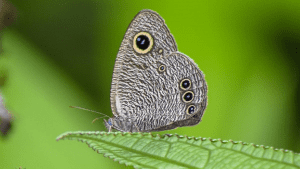TAG: GS 3: ECOLOGY AND ENVIRONMENT
THE CONTEXT: In a remarkable discovery, a four-ringed butterfly species, Ypthima cantliei, commonly known as the great four-ring, has resurfaced in India after a gap of 61 years.
EXPLANATION:
- This species belongs to the Satyrinae subfamily and was last documented in 1957 in Margherita, a town in eastern Assam.
- The butterfly was recently recorded in the Namdapha National Park, a biodiversity hotspot located in Arunachal Pradesh, which shares its eastern border with Myanmar.
- The rediscovery of this elusive butterfly was a result of the efforts of four researchers, and their findings have been published in a study by BNHS, bringing this rare species back into the spotlight.
Habitat and Morphological Features
- The Namdapha National Park, where the great four-ring was found, spans 1,985 square kilometers in the Changlang district of Arunachal Pradesh.
- The park is the easternmost tiger reserve in India and boasts a diverse range of elevations, from 298.7 meters to 4,498.8 meters above sea level.
- The butterfly was recorded during a survey conducted between 2018 and 2019 aimed at documenting the park’s butterfly diversity.
- The great four-ring is distinguishable by its dull brown-grey wings and characteristic ocelli.
- It has three yellow-ringed single eye spots on its hind wings and a larger bi-pupilled apical ocellus on its forewing.
- These features differentiate it from other species within the Ypthima genus, making it larger and more distinct.

Historical and Geographical Context
- The great four-ring was first recorded in the coal town of Margherita, Assam, named after an Italian queen by the chief engineer C.R. Paganini during the 1880s construction of Assam’s first railway line.
- The recent sighting in Namdapha suggests a broader range of this species, though little is still known about its current population or distribution.
Ypthima Genus and Its Diversity
- The Ypthima genus, to which the great four-ring belongs, is part of the Nymphalidae family.
- It one of the largest butterfly families globally, with around 6,000 species.
- India hosts 35 species of Ypthima, with 23 of these found in the northeastern region, highlighting the area’s rich butterfly biodiversity.
- The highest diversity of Ypthima is observed in China, particularly in the Yunnan and Sichuan provinces, and extends across Nepal, Bhutan, Myanmar, and northeastern India.
Arunachal Pradesh: A Biodiversity Hotspot
- Arunachal Pradesh, where Namdapha National Park is located, is a key region for butterfly diversity in India.
- The state is home to more than 600 of the 1,327 butterfly species recorded across the country, making it a crucial area for lepidopterological studies.
- The rediscovery of the great four-ring adds to the ecological importance of this region and underscores the need for continued biodiversity conservation efforts.
Namdapha National Park
- Namdapha National Park is a 1,985 km2 (766 sq mi) large protected area in Arunachal Pradesh of Northeast India.
- The park was established in 1983.
- With more than 1,000 floral and about 1,400 faunal species, it is a biodiversity hotspot in the Eastern Himalayas.
- The national park harbours the northernmost lowland evergreen rainforests in the world at 27°N latitude.
- It also harbours extensive dipterocarp forests, comprising the northwestern parts of the Mizoram-Manipur-Kachin rain forests ecoregion.
- Namdapha was originally declared a wildlife sanctuary in 1972, then a national park in 1983 and became a tiger reserve under Project Tiger scheme in the same year.

